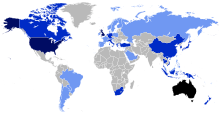ชาวออสเตรเลีย
พลเมืองออสเตรเลีย
ชาวออสเตรเลีย (อังกฤษ: Australians) มักเรียกตามสำนวนภาษาปากว่า ออสซี เป็นพลเมือง สัญชาติ และบุคคลที่มีส่วนเกี่ยวข้องกับประเทศออสเตรเลีย
 แผนที่ชาวออสเตรเลียโพ้นทะเลทั่วโลก | |
| ภูมิภาคที่มีประชากรอย่างมีนัยสำคัญ | |
|---|---|
| 25,464,116[1] | |
| 94,000–200,000[2][3] | |
| 165,000[4] | |
| 90,000[5][6] | |
| 70,000[7] | |
| 62,910[8] | |
| 30,000[9][10] | |
| 20,000–25,000[9][11] | |
| 20,000 (2011)[12] | |
| 12,000[13] | |
| 20,000[13] | |
| 10,000[13] | |
| 9,000[13] | |
| 6,000[13] | |
| 10,000[13] | |
| 5,000[13] | |
| 4,000[13] | |
| 4,000[13] | |
| 30,000[13] | |
| 14,000[13] | |
| 8,000[13] | |
| 10,000[13] | |
| 4,000[13] | |
| 6,000[13] | |
| 2,500[13] | |
| 2,000[13] | |
| 2,000[13] | |
| 1,000[13] | |
| 1,000[13] | |
| 4,000[13] | |
| 4,000[14] | |
| 4,000[13] | |
| 3,000[13] | |
| 3,000[13] | |
| 2,000[13] | |
| ภาษา | |
| ภาษาอังกฤษออสเตรเลีย · กลุ่มภาษาพื้นเมืองออสเตรเลีย · ภาษาชนกลุ่มน้อยอื่น ๆ[15] | |
| ศาสนา | |
| 52% คริสต์ (คาทอลิก, แองกลิคัน และนิกายอื่น ๆ)[16] 8% ไม่ใช่ศาสนาคริสต์[16] 30% ไม่มี[16][A] | |
| กลุ่มชาติพันธุ์ที่เกี่ยวข้อง | |
| ชาวนิวซีแลนด์, ชาวออสเตรเลียอะบอริจิน | |
ในช่วง ค.ศ. 1788 ถึงสงครามโลกครั้งที่สอง ผู้ตั้งรกถิ่นฐานและผู้อพยพส่วนใหญ่มาจากบริติชไอลส์ (โดยเฉพาะอังกฤษ, ไอร์แลนด์ และสกอต) ถึงแม้ว่าจะมีผู้อพยพจากจีนและเยอรมันในช่วงคริสต์ศตวรรษที่ 19
นับตั้งแต่นโยบายออสเตรเลียขาวสิ้นสุดลงใน ค.ศ. 1973 ออสเตรเลียเริ่มเปลี่ยนนโยบายให้เป็นไปตามความหลากหลายทางวัฒนธรรม และมีประชากรผู้อพยพมากเป็นอันดับ 8 ของโลก โดยมีประชากรเป็นผู้อพยพใน ค.ศ. 2019 ร้อยละ 30[17][18] และยังคงมีคลื่นอพยพลูกใหญ่และต่อเนื่องมาที่ออสเตรเลียจากทั่วโลกในคริสต์ศตวรรษที่ 21 โดยส่วนใหญ่มาจากทวีปเอเชีย[19]
หมายเหตุ
แก้- ↑ ตัวเลือกศาสนาในสำมะโนเป็นคำถามเสริม ทำให้จำนวนร้อยละมีไม่ถึง 100%
อ้างอิง
แก้- ↑ "3101.0 - Australian Demographic Statistics, Sep 2019". Australian Bureau of Statistics. 19 March 2020. สืบค้นเมื่อ 11 June 2020.
- ↑ Results – Community Survey 2013 เก็บถาวร 12 กุมภาพันธ์ 2020 ที่ archive.today American Fact Finder (US Census Bureau).
- ↑ "Special Feature: Australians in New York". Newyork.usa.embassy.gov.au. คลังข้อมูลเก่าเก็บจากแหล่งเดิมเมื่อ 26 June 2015. สืบค้นเมื่อ 2 April 2013.
- ↑ "Table 1.3: Overseas-born population in the United Kingdom, excluding some residents in communal establishments, by sex, by country of birth, January 2013 to December 2013". Office for National Statistics. 2 July 2015. สืบค้นเมื่อ 20 November 2015. Figure given is the central estimate. See the source for 95 per cent confidence intervals.
- ↑ "Australia's Rudd Dials Hong Kong Expats". The Wall Street Journal. 29 August 2013.
The 90,000 Australian citizens in Hong Kong—mostly ethnic Chinese..
- ↑ "Australian Federal Election Make sure you're enrolled to vote by 6pm HKT, 12 August 2013". Australian Consulate-General Hong Kong, China. 7 August 2013. คลังข้อมูลเก่าเก็บจากแหล่งเดิมเมื่อ 30 August 2018. สืบค้นเมื่อ 7 February 2014.
- ↑ Sam Worthington (12 September 2012). "Anzac Day AFL match the start of big things". Stuff.co.nz.
- ↑ "Estimated Resident Population by Country of Birth - 1992 to 2014". ABS.Stat/. 26 November 2008. คลังข้อมูลเก่าเก็บจากแหล่งเดิมเมื่อ 16 May 2015. สืบค้นเมื่อ 17 March 2016.
- ↑ 9.0 9.1 "Estimates of Australian citizens living overseas: as at December 2001" (PDF). southern-cross-group.org. คลังข้อมูลเก่าเก็บจากแหล่งเดิม (PDF)เมื่อ 20 July 2008.
- ↑ "Australians in Italy: The long view". Books.publishing.monash.edu. คลังข้อมูลเก่าเก็บจากแหล่งเดิมเมื่อ 3 มิถุนายน 2013. สืบค้นเมื่อ 2 เมษายน 2013.
- ↑ "Diplomatic appointment – Ambassador to Lebanon, 8 September 2010, Australian Minister for Foreign Affairs and Trade". Foreignminister.gov.au. 8 กันยายน 2010. คลังข้อมูลเก่าเก็บจากแหล่งเดิมเมื่อ 24 March 2014.
- ↑ "Lee Hsien Loong: Singapore in an Ever-More Connected World", Asia Society - Australia, 12 October 2012
- ↑ 13.00 13.01 13.02 13.03 13.04 13.05 13.06 13.07 13.08 13.09 13.10 13.11 13.12 13.13 13.14 13.15 13.16 13.17 13.18 13.19 13.20 13.21 13.22 13.23 13.24 "Immigrant and Emigrant Populations by Country of Origin and Destination". Migration Policy Institute. 2017. สืบค้นเมื่อ 2020-06-14.
- ↑ "Imigrantes internacionais registrados no Brasil". www.nepo.unicamp.br. สืบค้นเมื่อ 2021-08-20.
{{cite web}}: CS1 maint: url-status (ลิงก์) - ↑ "2011 Census QuickStats". Censusdata.abs.gov.au. คลังข้อมูลเก่าเก็บจากแหล่งเดิมเมื่อ 6 November 2015.
- ↑ 16.0 16.1 16.2 "Census of Population and Housing: Reflecting Australia - Stories from the Census, 2016 : Religion in Australia". Australian Bureau of Statistics. คลังข้อมูลเก่าเก็บจากแหล่งเดิมเมื่อ 20 กันยายน 2017. สืบค้นเมื่อ 27 มิถุนายน 2017.
- ↑ "Table 5.1 Estimated resident population, by country of birth(a), Australia, as at 30 June, 1996 to 2019(b)(c)". Australian Bureau of Statistics. สืบค้นเมื่อ 4 May 2020.
- ↑ "The Evolution of Australia's Multicultural Policy". Department of Immigration and Multicultural and Indigenous Affairs. 2005. คลังข้อมูลเก่าเก็บจากแหล่งเดิมเมื่อ 19 February 2006. สืบค้นเมื่อ 18 September 2007.
- ↑ "2018-19 Migration Program Report" (PDF). Department of Home Affairs (Australia). p. 19. สืบค้นเมื่อ 2020-06-14.
แหล่งข้อมูลอื่น
แก้- วิกิมีเดียคอมมอนส์มีสื่อเกี่ยวกับ ชาวออสเตรเลีย